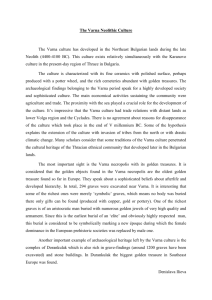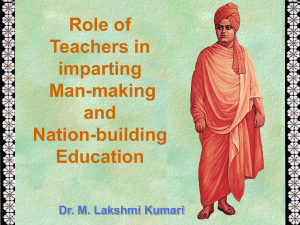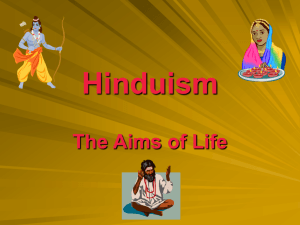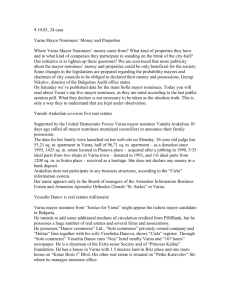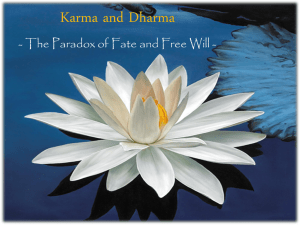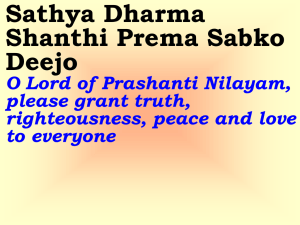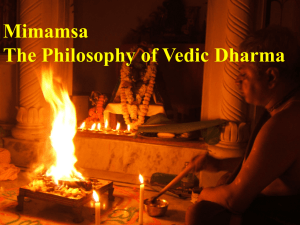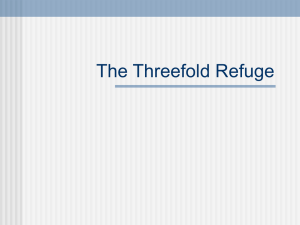Karma Marga Powerpoint
advertisement
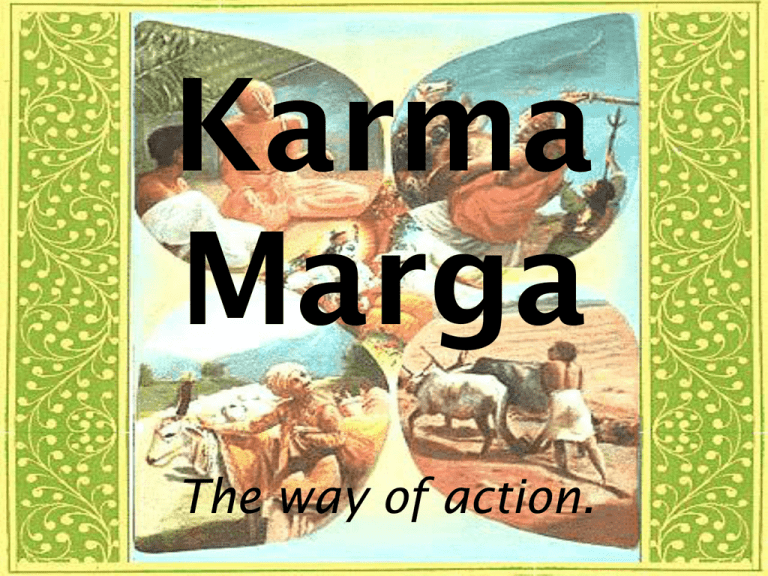
Karma Marga The way of action. Samsara Is the eternal cycle of birth, death and re-birth, into which every living thing is locked. Its inherent nature is suffering, so it is something that Hindus believe that we should wish to escape from. Atman Is trapped within… How is it trapped? Samsara How can it be liberated? Is liberation from… Moksha How is it trapped? By Karma – action & the fruit of action. Karma is a universal law, whatever you do, the universe must pay you back – good for good, evil for evil. Atman must return until the balance of good and evil restitution is worked out. He… is a doer of deeds that bear fruit, and enjoyer of what he has done… and assuming all forms, he roams about (in successive rebirths) according to his actions. The embodied one chooses forms, gross and subtle according to his qualities. Shvetashvatra Upanishad V.7, 12-13 How can one effect Karma? By obeying dharma – duty. If one acts according to dharma (dharmic action) one gains good karma, and by acting against dharma (adharmic action) one gains bad karma. Macrocosmic – similar to the vedic rita – the way that things should be. Microcosmic – one’s individual duty according to one’s position in society & stage in life. Four – there are four stages in life & four stages in society Level of society – the “caste” into which one is born Stage in life “Duty” – what should be done. “One’s duty according to one’s stage in life & position in society”. The Caste System “Casta” – Portuguese for “Colour” – thus another etic discourse, imposing foreign views on India. In fact, two hierarchies running side by side: Varna – Jati – Ancient religious social hierarchy, predicated upon spiritual pollution – divides all of Hindu society up into five groups. “Class system” based upon financial wealth & traditional employment of the family. Brahmana The dharma of a Brahmana is to perform his duties as a priest – to learn how to perform rituals, say mantras, offer sacrifices, instruct others in their dharma, and to be spiritually pure. Kshatriya The dharma of a Kshatriya is to prepare to fight to defend the principles of Dharma, to defend those elsewhere in the Varna system, and to be skilled in the arts of warfare & governance. Vaisya The dharma of a Vaisya is to make money, to fund the rest of the social system, and to be skilled in the means appropriate to doing that successfully. Sudra The dharma of a Sudra is to labour for the others, and to ensure that food & raw materials are produced for all in the system The ideal of the varna system is that it should be a perfect model of a well-organised society – each part interdependent with the others, and all of equal importance. Many scholars believe that this is an idealised model of Vedic society, and many Indian thinkers argue that it is a good model for contemporary societies. Each village should possess some representatives of each Varna, thus the different social roles are fulfilled. Greater is thine own work, even if this be humble, than the work of another, even if this be great. (Bhagavad Gita 18:47) Think thou also of thy duty, and do not waver. There is no greater good for a kshatriya than to fight in a righteous war. There is a war that opens the doors of heaven, Arjuna! Happy the warriors whose fate is to fight such a war. Bhagavad Gita 2,31-34. "The law of Varna teaches us that we have each one of us to earn our bread by following an ancestral calling..... teacher- and of a scavenger are equal and their due performance carries equal merit before God and at one time seems to have carried identical reward before man." “I believe that every man is born in the world with certain natural tendencies. Every person is born with certain definite limitations which he cannot overcome. From a careful observation of those limitations the law of Varna was deduced”. Hinduism as a religion is but an aspect of this social system, with no independent status apart from it. T. Parsons, The structure of Social Action, 557. Untouchables Scheduled castes The Dalits Are those who are totally outside the Varna system – at the bottom of the pollution hierarchy, whose physical presence may literally pollute, and who make up a large percentage of the poorest & most oppressed of Indian society Harijans Backward Castes Antiquity The Varna system is very old certainly going back to Vedic times, some have suggested as far as the Indus Valley. Few will be keen to abandon what is seen as an ancient part of their heritage. Religious Authority The Purusha Sukta of the Rig Veda describes the creation of the physical universe from the body of the Primal Man, sacrificed in a Yajña by the Gods. The Varna system is described as part of this created order – thus it is something created by the Gods, not by Mankind. When they divided the man, into how many parts did they disperse him? What became of his mouth, what of his arms, what were his two thighs and his two feet called? His mouth was the Brahmana, his arms were made into the Kshatriyas, his two thighs were the Vaishyas, and from his feet the Sudras were born. (Rig Veda X. xc. 11-12). Commensality Commensality literally means “The people that you eat with”. Of course, in a system based upon purity, you can only eat with people as pure, or purer than you, and you can certainly only eat food prepared by someone as pure, or purer than you. Food prepared by a lower Varna can be viewed as polluting. Commensality This also effects where you live as well, and in the villages of India a good deal more than that. High Varna individuals will have houses nearer to the well (and some Dalits can only draw water at night, or must use a different well). Some Dalits still remain effectively banned from some temples, although such discrimination is illegal in modern India. Endogamy Endogamy is a term used to denote marriage within a group, and both Varna and Jati are extremely important when Indian Parents are selecting a potential partner for their children. Brahmacharya Vanaprashta Grihastha Sannyasin Brahmacharya The Dharma of a Brahmacharya is to submit themselves to their Varna – Guru, to learn the skills that they will need to fulfil their Varnadharma in later life. They should work hard, be obedient, practice celibacy, and self-discipline. Grihastha The Dharma of a Grihastha is to marry and raise children. They should practice their Varnadharma, and where appropriate, earn money to support the other Varnas in society. They should perform certain religious rituals. Vanaprastha The Dharma of a Vanaprastha is to retire from public life, and devote more time to personal religious practice, and the religious education of (grand) children. Sannyasin The Dharma of a Sannyasin is to renounce all aspects of society, and to go in search of personal spiritual development. Four – there are four stages in life & four stages in society Level of society – the “caste” into which one is born Stage in life “Duty” – what should be done. “One’s duty according to one’s stage in life & position in society”.
